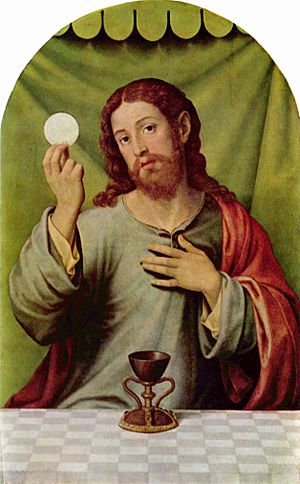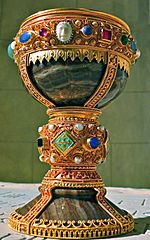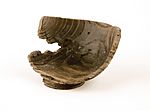Holy Chalice facts for kids
The Holy Chalice, also known as the Holy Grail, is a very important cup in Christian stories. People believe it was the cup Jesus used during the Last Supper. This was the special meal he shared with his disciples before he died.
The Bible says Jesus shared wine from a cup at this meal. He said it was a sign of a new promise, or "covenant," made with his blood. This event is why many Christian churches use wine and a special cup, called a chalice, in their worship today. This part of the service is called the Eucharist.
Later, in the late 1100s, a writer named Robert de Boron connected the Holy Chalice to an older magical item. This item was the Holy Grail from the stories of King Arthur. Since then, many King Arthur tales, like Le Morte d'Arthur, have linked the two. Today, a cup kept in the Cathedral of Valencia in Spain is thought by some to be the real Holy Chalice from the Last Supper.
Contents
The Last Supper: A Special Meal
The Gospel of Matthew (chapter 26) tells us about the Last Supper. Jesus took a cup and gave thanks. Then he gave it to his disciples, saying:
"Drink this, all of you; for this is My blood of the covenant, which is poured out for many for the forgiveness of sins."
This important event is also described in the gospels by Mark and Luke. The Apostle Paul also wrote about it in his letters. This story, along with Jesus breaking bread, is the basis for the Eucharist or Holy Communion. This is a special ceremony celebrated regularly in many Christian churches. The Bible mentions the cup only during the Last Supper. It does not say anything else special about the cup itself.
Some old stories say that Saint Peter took the cup to Rome. Later, in 258 AD, Christians were being treated badly by Emperor Valerian. The Romans wanted Christians to give up their holy items. But Pope Sixtus II gave the cup to his helper, Saint Lawrence. Lawrence then gave it to a Spanish soldier named Proselius. He told Proselius to take it to safety in Spain, Lawrence's home country.
Medieval Stories and the Holy Grail
The Chalice in Art
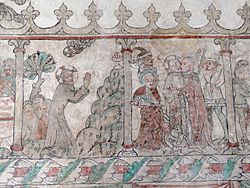
The Holy Chalice became more important in art during the Middle Ages. Paintings often showed Jesus praying in the Garden of Gethsemane. In these pictures, a shining Holy Chalice would appear on top of a mountain. This showed Jesus' words, "Let this cup be taken from me." Sometimes, the Chalice was shown with a glowing light, like a halo. This made it seem like a holy object, representing the Holy Spirit.
The Holy Grail Connection
The Holy Grail first appeared in King Arthur stories in the 1100s. It was a magical item. Soon after, it became linked with the Holy Chalice.
The "Grail" story became mixed with the Holy Chalice story. The idea that Joseph of Arimathea was connected to the Holy Chalice came from Robert de Boron's book in the late 1100s. By the 1200s, the full "Grail legend" said that the Holy Grail was the same as the Holy Chalice used at the Last Supper. It was also said that Joseph of Arimathea used it to collect Christ's blood. He then supposedly brought it to Spain.
Medieval Cups Claimed as Holy
In the Middle Ages, two main cups were said to be the Holy Chalice in Western Europe.
The Valencia Chalice
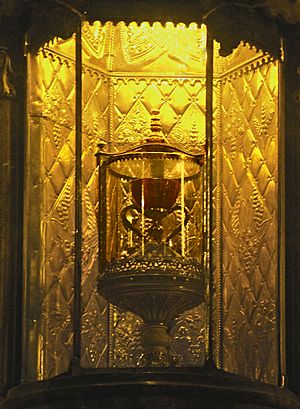
The Holy Chalice, or Santo Cáliz, is a cup made of agate. It is kept in the Cathedral of Valencia in Spain. Many people believe this is the actual Holy Grail used by Jesus at the Last Supper. It is in its own special chapel, and many people visit it. This cup is not said to have magical powers.
The cup itself is made of dark red agate. It is about 9 centimeters (3.5 inches) wide. It sits on a base with a stem and two curved handles. This base is made from another type of stone called chalcedony. The whole object is about 17 centimeters (7 inches) tall. The bottom part of the cup has some old Arabic writing. The base, stem, and handles were added later. But the red agate cup itself was likely made in the Middle East, between 200 BC and 1 AD.
The first clear mention of this cup is from 1134. It was in a list of treasures at a monastery called San Juan de la Peña. The list said it was the cup in which "Christ Our Lord consecrated his blood." It also said Saint Lawrence sent it to Spain.
In 1399, the monastery gave the cup to King Martin of Aragon. He gave them a gold cup in return.
Pope John Paul II used the Holy Chalice in Valencia during a Mass in 1982. He called it "a witness to Christ's passage on earth." In 2006, Pope Benedict XVI also used it for a Mass in Valencia. He called it "this most famous chalice."
The Genoa Chalice
The Sacro Catino is a hexagonal (six-sided) dish. It is made of green Egyptian glass. It is about 9 cm (3.5 inches) high and 33 cm (13 inches) wide. It was brought to Genoa, Italy, in 1101. It was part of the treasures taken from a city called Caesarea.
At first, people thought it was made of emerald. They believed emerald had special powers. But it was not until the late 1200s that someone claimed it was the Holy Grail.
In 1805, the dish was taken to Paris by Napoleon. It was damaged when it was returned to Genoa in 1816. That's when people realized it was made of glass, not emerald.
Other Modern Candidates
Besides the Valencia Chalice and the Sacro Catino, other items have been called the "Holy Grail" or "Holy Chalice" more recently. This happened as the Grail legends became more popular in the 1800s.
Chalice of Doña Urraca
The Chalice of Doña Urraca is kept in the Basilica of San Isidoro in León, Spain. This cup was not traditionally linked to the Holy Chalice. But in 2014, a book suggested it might be. The book said Egyptian soldiers took it from Jerusalem. Then, an Egyptian ruler gave it to a ruler in Spain. This Spanish ruler then gave it to the Kings of Leon in the 1000s. This was to stop them from attacking his city.
Antioch Chalice
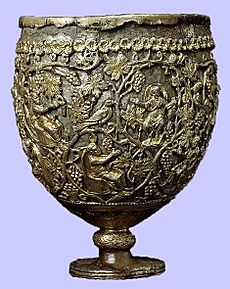
This object is made of silver-gilt (silver covered with gold). It was found in Antioch in 1910. At first, people thought it was an early Christian chalice. It was even sold as the "Holy Chalice." But experts now believe it is actually a standing lamp from the 500s. It is now in the Metropolitan Museum of Art in New York.
Nanteos Cup
The Nanteos Cup is a medieval wooden bowl. It was kept for many years at Nanteos Mansion in Wales. In the late 1800s, people said it had amazing healing powers. It was also believed to be made from a piece of the True Cross (the cross Jesus died on). In the early 1900s, it became known as the Holy Chalice.
|
See also
 In Spanish: Santo Cáliz de la Catedral de Valencia para niños
In Spanish: Santo Cáliz de la Catedral de Valencia para niños


